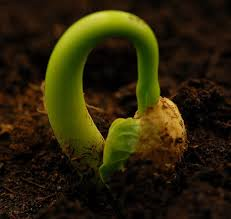
The challenge of seed starting is to have sturdy, well-grown seedlings ready to plant at the right time. As a general rule, seedlings need four to eight weeks to reach planting size. Most leafy greens (lettuces, mustards and arugula, for example) sprout fast and are ready to plant quickly. Cabbage, broccoli and their relatives need a bit longer to reach transplanting size, while some summer vegetables, like peppers and eggplant, take even longer. Consult the Master Gardener's Vegetable Planting Calendar (http://ucanr.edu/sites/ucmgnapa/Gardening_Books/Vegetable_Planting_Calendar/) to determine when to start seeds for the vegetables you want.
You'll need containers, seed-starting mix and a suitable place for the plants to grow. You can use any containers—new, used or repurposed—as long as they drain well. Wash containers well to remove debris, then soak them for 10 minutes in a 10 percent bleach solution (nine parts water to one part bleach). This step helps prevent damping off, a disease caused by soil-dwelling fungi. A sterile potting mix also protects against these fungal diseases. I like to use a potting soil specifically formulated for starting seeds, but regular potting soil will work, too.
Moisten the planting mix before filling containers. Plant two or three seeds per cell or small pot at the recommended planting depth, then gently firm the soil. A rule of thumb is to plant two to three times as deep as the seed diameter. Label your containers, marking the pot directly with an indelible marker or using a plant stake. You can make perfectly good plant stakes by cutting up yogurt cartons or using popsicle sticks.
Water the containers gently and let drain. At this point, I like to cover the pots loosely with plasticand put them in a warm place away from direct sunlight until the seeds sprout. If you don't have a warm spot,you can hasten sprouting with a seed-starting mat, which warms the containers from the bottom. This technique is especially helpful for the seeds of heat-loving plants like tomatoes.
I check my seeds daily. Under the right conditions, some will sprout in a couple of days; others will take up to two weeks. Most seed packets provide an estimate. Once seeds sprout, I take them off the warm mat and remove the plastic covering. The soil in small pots can dry out quickly, so keep water handy and gently add as needed. In warm spring weather, I sometimes water twice a day.
A few weeks after seeds sprout, most vegetables need thinning to one seedling per pot or cell. Snip extra seedlings at the soil line rather than pulling them out so you don't disturb the roots of the seedling you're keeping.
Young seedlings need light, preferably from a south-facing window. Seedlings should be as wide as they are tall; spindly seedlings are probably not getting enough light. You can supplement natural light, if necessary,with a shop light and fluorescent bulbs. Keep the light source about six inches above the plants, and raise the lights as the plants grow.
More time consuming but equally effective for me has been to move my seedlings in and out of the daylight. On sunny days, I move my seedlings to a deck to get direct morning light and afternoon shade. In the evenings, I move them indoors. As they get closer to transplant size, I leave them in direct sun longer. If the weather is warm enough, I'll leave them outside overnight. By the time I want to put them into the garden, they will be acclimated to the weather outside.
I recommend that you start twice as many plants as you think you need to allow for mishaps.If, in the end, you don't need those extra plants, you can have the pleasure of sharing them with friends and fellow gardeners.
Workshop: Napa County Master Gardeners will hold a workshop on “Propagation and Seed Starting” on Sunday, March 1, from 2 p.m. to 4 p.m., at Yountville Community Center in Yountville. Master Gardeners will discuss and demonstrate several types of propagation methods, including division, soft wood cuttings, grafting and seed starting. Learn about the tools and techniques that lead to successful propagation and have a hands-on experience. To register, contact the Parks and Recreation Department at 707-944-8712 or visit its web site.
Master Gardeners are volunteers who help the University of California reach the gardening public with home gardening information. Napa County Master Gardeners ( http://ucanr.org/ucmgnapa/) are available to answer gardening questions in person or by phone, Monday, Wednesday and Friday, 9 a.m. to Noon, at the U. C. Cooperative Extension office, 1710 Soscol Avenue, Suite 4, Napa, 707-253-4143, or from outside City of Napa toll-free at 877-279-3065. Or e-mail your garden questions by following the guidelines on our web site. Click on Napa, then on Have Garden Questions? Find us on Facebook under UC Master Gardeners of Napa County.